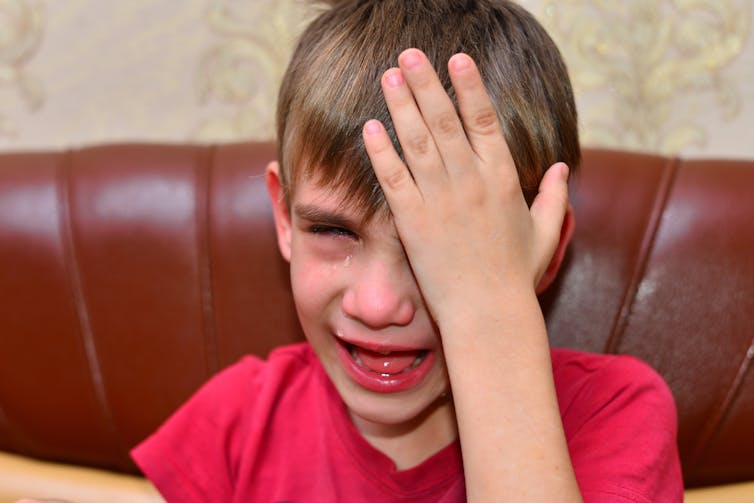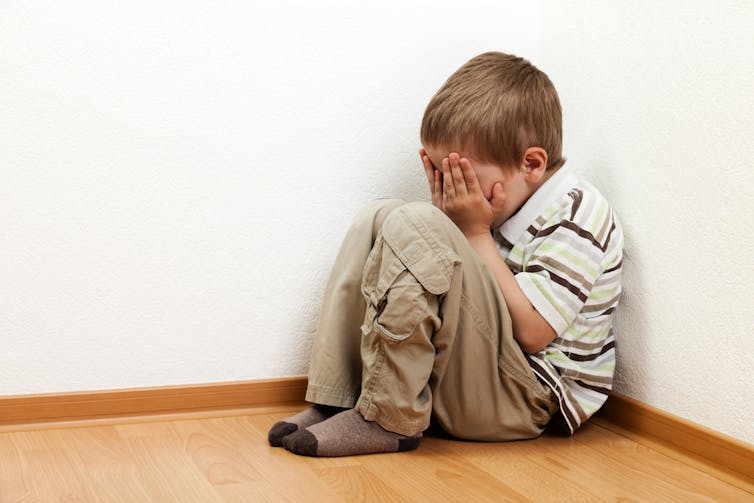Acting out, acting their age or something more serious? Dealing with difficult behaviour in children
- Written by Katrina Barker, Senior Lecturer in Educational Psychology, Western Sydney University
This series draws on the latest research on back to school transitions. In it, the experts explain how best to prepare children for school, and counter difficulties such as stress or bad behaviour.
At some stage in every child’s life they will exhibit defiant, impulsive or even disobedient behaviours.
A lot of this is normal, but when behaviour disrupts a child’s everyday functioning, it becomes abnormal and parents should seek professional advice. Parents can make a difference by using evidence-based strategies to encourage positive behaviours.
When does ‘normal’ behaviour become abnormal behaviour?
For almost one in seven Australians aged four to 17 years, the occurrence of disruptive behaviour is significant in nature, persists over time and tends to mismatch with their developmental stage.
Signs the behaviours are more severe include if it impacts on the child’s functioning at school or with family and friends, and if it causes the child personal distress. These indicate the behaviour needs deeper investigation and the support of a specialised professional as early as possible.
There is disagreement about whether preschool-aged children can or should be diagnosed with disorders, given the vast range of behaviour considered “normal” at this age. Most disorders tend to be diagnosed in school aged children, generally aged 10-14 years.
 If a child’s own behaviour causes them distress, this may be a signal that they have more severe behaviourla issues.
Shutterstock
If a child’s own behaviour causes them distress, this may be a signal that they have more severe behaviourla issues.
Shutterstock
Where can parents go for help?
Knowing where to start can be overwhelming when seeking support for severe and persistent disruptive behaviour. Avoid “Dr. Google” or websites claiming to provide symptom checkers, as they can give alarmist findings.
You should read and learn more about the various behavioural disorders to become informed, but always make sure you’re using reputable sources. These include beyondblue, Reach Out, Headspace, KidsMatter and MindMatters.
Some of the resources teacher educators refer to can be useful, such as Response Ability, which provides fact sheets and podcasts on various behavioural disorders.
If you’re still concerned after doing some reading, a visit to the GP is a good starting point. The GP can provide an initial assessment and refer the child and family to other professionals if additional assessment, treatment and support are necessary.
Access to specialists, such as a paediatrician or psychiatrist, requires a GP’s referral. Referrals are not required to visit a psychologist, but it’s best to visit the GP initially to help determine whether this is necessary. The GP can also refer to someone they highly recommend.
Pitfalls of punishment
Meltdowns, yelling and defiance or even being ignored by a child is usually normal – most likely, they are just acting their age. For the majority of children, instances of disruptive behaviour are minor in nature and infrequent. Importantly though, it’s possible to prevent difficult behaviour by using some effective, evidence-based strategies.
Read more: 'No, I don't wanna... wahhhh!' A parent's guide to managing tantrums
Research shows using positive strategies to address difficult behaviour is more effective than using punishment or coercion. Although you might notice an immediate response, punishment only temporarily stops the behaviour, and it’s likely the behaviour will appear again in the future.
Think about when you drive past a speed camera. What do most people do? They temporally slow down, but once they’ve passed the camera they usually speed up again.
 Punishment and can have a number of negative consequences, including rebellion.
Shutterstock
Punishment and can have a number of negative consequences, including rebellion.
Shutterstock
Punishment also has a number of unintended consequences, such as undermining relationships. It can lead to rebellion and reduces a person’s autonomy and problem-solving skills.
Effective strategies to improve behaviour
Using positive behavioural strategies not only decreases unwanted behaviour, it promotes positive social behaviour and strengthens relationships. Some strategies will be more effective than others, depending on the child’s preferences. Try a few different strategies, and if one doesn’t work, stop using it. Move to another technique. Try some of these effective strategies:
give attention through warmth and affection when your child is behaving appropriately. Tell them what about their behaviour you like, and smile when praising. For example, “I really like when you listen carefully, we can get so much more done and get to the good things faster”
give praise and rewards immediately after the desirable behaviour is displayed, rather than waiting until later
think about what your child would value as a reward so it has appeal and drives their motivation to be good. Would they prefer time to play on a device, a toy, food treat, or choice of a movie?
for particularly challenging behaviour, consider setting up a reward chart. Reward your child frequently throughout the day by catching them being good and when you notice improvements, gradually reduce how often you reward them
offering choices helps them feel ownership over decision making and assist them in evaluating the consequences of their choices
know when to ignore, and when to intervene. It’s unrealistic to discipline every challenging behaviour, so ignore the little things. Consider overlooking the occasional mess, whining or slowness to respond to requests
give clear instructions and set behaviour expectations, such as “use a talking voice at all times” or “keep your hands and feet to yourself” and so on. Negotiating the expectations with your child will increase their commitment to follow them. You can maximise the effectiveness of setting rules by also negotiating rewards for successfully following them and consequences if they do not
before you leave the house, remind them of the rules and the rewards for following them
actively listen to your child by stopping what you’re doing and taking time out. Behaviour concerns often arise because the child is seeking your attention.
 If bad behaviour continues after employing positive behavioural strategies, it’s time to introduce consequences.
Shutterstock
If bad behaviour continues after employing positive behavioural strategies, it’s time to introduce consequences.
Shutterstock
If you find the behaviour persists after using a range of positive strategies, it’s time to introduce consequences. A continuum of consequences start with the least obtrusive strategies and incrementally increase in severity.
Read more: What are the best ways to discipline kids?
First, use prompts such as eye contact or facial expressions to note disapproval.
Then, remind them of what behaviour you want to encourage. For example, “what should you be doing?”
Move closer to the child and use a calm matter-of-fact tone of voice, or try using a whisper voice.
Redirect behaviour by giving choices. For older children, ask them what would be a better choice of behaviour. For younger children, give them constrained choices. For example, please put the lollies back in the bag or give all of the lollies to me.
Remind the child of the behaviour you do want to see.
Let them know they have three warnings and what the consequence is if they continue. Follow through on this, and don’t change the number of warnings or consequence. This means you need to be measured in the timing of your warnings and match the action to the consequence. Consistency is the key.
Finally, when used well, time out can be effective. Consider having an appropriate location for the time-out period. It needs to be quiet, private with minimal stimulation.
Act quickly after the behaviour occurs and give a concise reason for sending them to time-out. Prompt them to think about what they could have been doing differently. Ignore secondary behaviours while in the time-out period (like screaming, wriggling or pleading).
Avoid talking to them until the end of the time-out period. Two to three minutes is usually the amount of time. Before exiting, ask the child to remind you why they were put in time out and what they could have done differently. Catch them being good as soon as you can and remind them how much you love them.
Authors: Katrina Barker, Senior Lecturer in Educational Psychology, Western Sydney University



